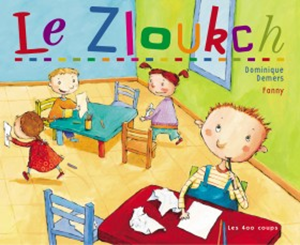 by Dominique Demers
by Dominique Demers
Zachary est un petit garçon presque comme les autres… Jusqu’au jour où il dessine un Zloukch. Ce Zloukch n’est ni un chat, ni un poisson, ni un kangourou, c’est un Zloukch, un point c’est tout. Hommage à la créativité des petits, cet album, premier d’une série, touchera les enfants par sa simplicité et sa grande justesse d’émotion.
Strategies/Skills Used
Reading Strategy 1: Access background information.
Reading Strategy 2: Predict what will be learned or what will happen.
Reading Strategy 5: Make mental pictures.
Reading Strategy 9: Identify and interpret literary elements in different genres.
Reading Strategy 11: Make inferences and draw conclusions.
Reading Strategy 12: Reflect and respond.
Writing Skill 4: I write so my thoughts flow smoothly and are easy to read.
Writing Skill 6: I choose the tone and point of view that suit my writing purpose.
Writing Skill 8: I re-read, reflect, revise and edit.
 TEACHING THE ACTIVITY: PRE-READING
TEACHING THE ACTIVITY: PRE-READING
(1) Select key illustrations from the book to introduce the story to the class, using the strategy Split Images. Be sure not to include any images of the Zloukch, as you don’t want to give this part of the story away!
(2) Sort all illustrations created in the Split Images activity into groups and spread them around the class. (Example: all reproductions of image #1 at one table, all reproductions of image #2 at another, etc.)
(3) Invite students on a Gallery Walk to observe all the images created and call attention to their differences and similarities.
(4) Initiate a whole-class discussion based on the descriptions and illustrations created to predict what the story may be about.
 TEACHING THE ACTIVITY: DURING READING
TEACHING THE ACTIVITY: DURING READING
(5) Read the story aloud to your class and stop on page 13, after the sentence, “Un Zloukch! répondit Zachary.”
(6) Have students Listen-Sketch-Predict to answer four questions asked by students in the story:
- C’est quoi un Zloukch? (What is a Zloukch?)
- Dans quel pays ça vit? (What country does it live in?)
- Qu’est-ce que ça mange? (What does it eat?)
- À quoi ça ressemble? (What does it look like?)
Allow students enough time to write each question in one of the four boxes and to start writing and/or drawing their predictions.
(7) Continue reading and stop on page 20: “Et voilà ce qu’ils découvrirent…” Prepare your class for the big reveal of the Zloukch! Allow students, in small groups, to compare their own predictions to that of the Zloukch in the story.
 (8) Continue reading and stop at the end of page 24: “Monique était triste pour Zachary.” Use the Bubble Thinking strategy along with Les bulles de pensées to have students record what they think the characters in this picture are thinking and saying in the thought and speech bubbles provided. Lead a little discussion about when they might have felt the same way or been in a similar situation to Zachary. Ask what we should do or take away from such a situation.
(8) Continue reading and stop at the end of page 24: “Monique était triste pour Zachary.” Use the Bubble Thinking strategy along with Les bulles de pensées to have students record what they think the characters in this picture are thinking and saying in the thought and speech bubbles provided. Lead a little discussion about when they might have felt the same way or been in a similar situation to Zachary. Ask what we should do or take away from such a situation.
(9) Finish reading the story, drawing attention to the value and
 TEACHING THE ACTIVITY: POST-READING
TEACHING THE ACTIVITY: POST-READING
(10) Point out that the last sentence states that the story has actually only just begun! Use the strategy Serendipity Writing to have students collectively write their own story of Zachary and le Zloukch. Variations can include having every student contribute a sentence, paragraph, beginning, middle, end, or even phrase.
(11) Once students get their own story back, allow them time to add any necessary finishing touches.
(12) Consider having students read their Serendipity Stories out loud in an author’s chair to smaller groups or even to buddy classes. The results can often be quite humorous.
 TEACHING THE ACTIVITY: POST-READING EXTENSION
TEACHING THE ACTIVITY: POST-READING EXTENSION
(13) Use the Snatching a Series strategy, along with any of the following books from the Le Zloukch series, to create a new storyline featuring these familiar story characters. The goal of this activity is to focus on the story development of setting and plot. Other titles include Zachary et son Zloukch, Le Gloubilouache, Le cornichonnet gaffeur, and Les flipattes conteurs.